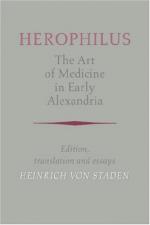|
This section contains 348 words (approx. 2 pages at 300 words per page) |
World of Scientific Discovery on Herophilus
Sometimes called the father of anatomy, Herophilus was born in Chalcedon, Asia Minor. Little is known about his life; the date and place of his death have been completely lost, as have all his writings. Herophilus studied medicine under Praxagoras of Cos and then at Alexandria, where he later taught and practiced medicine. In Alexandria, Herophilus had the unique opportunity to practice human dissection, a research technique not allowed elsewhere. Herophilus even performed public dissections. His work was highly regarded, and the medical school he founded at Alexandria attracted scores of students.
Herophilus made many anatomical studies of the brain. He distinguished the cerebrum (larger portion) from the cerebellum (smaller portion), pronounced the brain to be the seat of intelligence, and identified several structures of the brain, several of which still carry his name. He discovered that the nerves originate in the brain, was the first to distinguish nerves from tendons, and noted the difference between motor nerves (those concerned with motion) and sensory nerves (those related to sensation). He traced the optic nerve and described the retina. He studied the liver extensively and described and named the duodenum, the first part of the small intestine.
Drawing a distinction between arteries and veins, Herophilus noted the arterial pulse and developed standards for its measurement and use in diagnosis. He thought that arterial pulsation was involuntary, rising from dilation and contraction of arteries due to impulses sent from the heart. He corrected the idea that arteries carry air rather than blood. Herophilus also wrote a treatise on midwifery and accurately described the ovaries, the uterus, and the tubes leading from the ovaries to the uterus (later named the Fallopian tubes). In the field of medical treatment, Herophilus sensibly recommended good diet and exercise, but was also an enthusiastic advocate of bleeding and frequent drug therapy.
Although his medical school languished after his death, Herophilus (and his younger successor Erasistratus) established the disciplines of anatomy and physiology, which did not significantly advance before Galen in the second century and then the early modern anatomists of the thirteenth century.
|
This section contains 348 words (approx. 2 pages at 300 words per page) |


